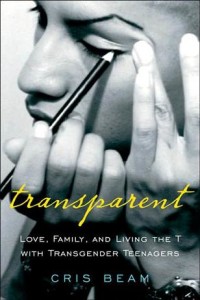In conversation with some friends a couple months ago it occurred to me that I don’t know anyone who is transgender. Or, I might, but I don’t know. I also realized that I have a rather cursory understanding about the issues facing the Transgender community outside of the coverage of said issues in the media over the past few years. It was fortuitous then that as part of the Read Harder Challenge task number five is reading a book either about or by someone who identifies as LBGTQ. And on their list of suggestions was Transparent: Love, Family, and Living the T with Transgender Teenagers. I was already planning on reading Alan Cumming’s memoir and that would’ve fulfilled the task, but this was a great resource for me and an excuse to get outside my comfort zone. Which is the whole idea of the Read Harder Challenge, anyway.
Cris Beam writes about her experiences with the transgender community in Los Angeles between 1997 and 2005, but more specifically about a handful of transgirls with whom she interacts. Transparent is both a general information text about what being transgendered means, an account of the various social injustices that befalls these women – especially the under aged ones who are kicked out by their families, or choose to run. It is also a very personal story of Beam’s fostering of one of the girls and what that experience gave her.
While this book talks about an important topic, and generally handles it with grace, it is not a perfect book. The front half of the book dragged, and was at times confusing. When many of these girls (which is the predominant group Beam interacted with) begin living full, or even part time as women, they often change their names several times trying to find the one that matches who they know themselves to be. This means one person in the book is often referred to by 3 or 4 different names over the course of part one of the book- which was purely confusing to me. I wish Beam had chosen to refer to each woman by the name she used last, and of course making references to their birth names when appropriate.
The other criticism that can be laid against this book is that it, at times, can read as a white woman rescuing a person of color. There are lots of a book that fit that description, but in Transparent Beam is also working through her own issues of abandonment by a parent because she is a lesbian, which gives her a place to make correlations to the experiences she is witnessing and interacting with. I never felt a sense of a personal crusade, I saw someone chronicling how one choice to volunteer their time led to several years of decisions that made someone unexpected a part of their family. This is an experience that I can relate to.
This book is my cannonball book, and I’m happy that it was this one – a book you should read if the topic is of interest to you, or even if you think it isn’t.
